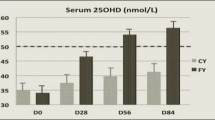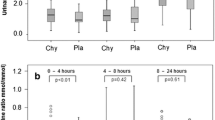Abstract
In the Western world, increased consumption of carbonated soft drinks combined with a decreasing intake of milk may increase the risk of osteoporosis. This study was designed to reflect the trend of replacing milk with carbonated beverages in a group of young men on a low-calcium diet and studies the effects of this replacement on calcium homeostasis and bone turnover. This controlled crossover intervention study included 11 healthy men (22–29 years) who were given a low-calcium basic diet in two 10-day intervention periods with an intervening 10-day washout. During one period, they drank 2.5 l of Coca Cola per day and during the other period 2.5 l of semi-skimmed milk. Serum concentrations of calcium, phosphate, 25-hydroxycholecalciferol, 1,25-dihydroxycholecalciferol (1,25(OH)2D), osteocalcin, bone-specific alkaline phosphatase (B-ALP) and cross-linked C-telopeptides (CTX), plasma intact parathyroid hormone (PTH) and urinary cross-linked N-telopeptides (NTX) were determined at baseline and endpoint of each intervention period. An increase in serum phosphate (P<0.001), 1,25(OH)2D (P<0.001), PTH (P=0.046) and osteocalcin (P<0.001) was observed in the cola period compared to the milk period. Also, bone resorption was significantly increased following the cola period, seen as increased serum CTX (P<0.001) and urinary NTX (P<0.001) compared to the milk period. No changes were observed in serum concentrations of calcium or B-ALP. This study demonstrates that over a 10-day period high intake of cola with a low-calcium diet induces increased bone turnover compared to a high intake of milk with a low-calcium diet. Thus, the trend towards a replacement of milk with cola and other soft drinks, which results in a low calcium intake, may negatively affect bone health as indicated by this short-term study.
Similar content being viewed by others
References
Ettinger MP (2003) Aging bone and osteoporosis: strategies for preventing fractures in the elderly. Arch Intern Med 163:2237–2246
World Health Organization (1999) Osteoporosis: Both health organizations and individuals must act now to avoid an impeding epidemic. WHO, Geneva
Brixen KT, Christensen B, Ejersted C, Langdahl BL (2004) Teriparatide (biosynthetic human parathyroid hormone 1–34): a new paradigm in the treatment of osteoporosis. Pharmacol Toxicol 94:260–270
Whiting SJ, Vatanparast H, Baxter-Jones A, Faulkner RA, Mirwald R, Bailey DA (2004) Factors that affect bone mineral accrual in the adolescent growth spurt. J Nutr 134:696S-700
Kalkwarf HJ, Khoury JC, Lanphear BP (2003) Milk intake during childhood and adolescence, adult bone density, and osteoporotic fractures in US women. Am J Clin Nutr 77:257–265
Whiting SJ, Healey A, Psiuk S, Mirwald R, Kowalski K, Bailey DA (2001) Relationship between carbonated and other low nutrient dense beverages and bone mineral content of adolescents. Nutr Res 21:1107–1115
Mrdjenovic G, Levitsky DA (2003) Nutritional and energetic consequences of sweetened drink consumption in 6- to 13-year-old children. J Pediatr 142:604–610
Harnack L, Stang J, Story M (1999) Soft drink consumption among US children and adolescents: nutritional consequences. J Am Diet Assoc 99:436–441
Heaney RP, Rafferty K (2001) Carbonated beverages and urinary calcium excretion. Am J Clin Nutr 74:343–347
Wyshak G, Frisch RE (1994) Carbonated beverages, dietary calcium, the dietary calcium/phosphorus ratio, and bone fractures in girls and boys. J Adolesc Health 15:210–215
McGartland C, Robson PJ, Murray L et al (2003) Carbonated soft drink consumption and bone mineral density in adolescence: the Northern Ireland Young Hearts project. J Bone Miner Res 18:1563–1569
Kim SH, Morton DJ, Barrett-Connor EL (1997) Carbonated beverage consumption and bone mineral density among older women: The Rancho Bernado Study. Am J Public Health 87:276–279
Wyshak G (2000) Teenaged girls, carbonated beverage consumption, and bone fractures. Arch Pediatr Adolesc Med 154:610–613
Sandström B, Aro A, Becker W, Lyhne N, Pedersen JI, Pórsdóttir I (1996) Nordiska näringsrekommendationer 1996. 113–114 (The Nordic Dietary Recommendations)
Johansen DL, Eiken PA (2002) Cola as a possible cause of secondary hyperparathyroidism. Ugeskrift for laeger 164:4290–4291 (report of two case stories)
Guerrero-Romero F, Moran MR, Reyes E (1999) Consumption of soft drinks with phosphoric acid as a risk factor for the development of hypocalcemia in postmenopausal women. J Clin Epidemiol 52:1007–1010
Mazariegos-Ramos E, Guerrero-Romero F, Rodriguez-Moran M, Lazcano-Burciaga G, Paniagua R, Amato D (1995) Consumption of soft drinks with phosphoric acid as a risk factor for the development of hypocalcemia in children: A case-control study. J Pediatr 126:940–942
Petridou E, Karpathios T, Dessypris N, Simou E, Trichopoulos D (1997) The role of dairy products and non alcoholic beverages in bone fractures among school age children. Scand J Soc Med 25:119–125
Danish Food and Venterinary Administration (1006) Danskernes Kostvaner 1995. Hovedresultater. Danish Food and Veterinary Administration, Copenhagen, Denmark (survey on the dietary food patterns in the Danish population)
Houillier P, Nicolet-Barousse L, Maruani G, Paillard M (2003) What keeps serum calcium levels stable? Joint Bone Spine 70:407–413
Calvo MS, Kumar R, Heath H III (1988) Elevated secretion and action of serum parathyroid hormone in young adults consuming high phosphorus, low calcium diets assembled from common foods. J Clin Endocrinol Metab 66:823–829
Estepa JC, Aguilera-Tejero E, Lopez I, Almaden Y, Rodriguez M, Felsenfeld AJ (1999) Effect of phosphate on parathyroid hormone secretion in vivo. J Bone Miner Res 14:1848–54.
Bizik BK, Ding W, Cerklewski FL (1996) Evidence that bone resorption of young men is not increased by high dietary phosphorus obtained from milk and cheese. Nutr Res 16:1143–1146
Metz JA, Anderson JJ, Gallagher PN Jr (1993) Intakes of calcium, phosphorus, and protein, and physical-activity level are related to radial bone mass in young adult women. Am J Clin Nutr 58:537–542
Brot C, Jorgensen N, Madsen OR, Jensen LB, Sorensen OH (1999) Relationships between bone mineral density, serum vitamin D metabolites and calcium:phosphorus intake in healthy perimenopausal women. J Int Med 245:509–516
United States Institute of Medicine, Food and Nutrition Board (1997) Dietary reference intakes: calcium, phosphorus, magnesium, vitamin D and flouride. National Academy Press, Washington, DC
Barger-Lux MJ, Heaney RP, Stegman MR (1990) Effects of moderate caffeine intake on the calcium economy of premenopausal women [published erratum appears in Am J Clin Nutr 1991 Jan;53(1):182]. Am J Clin Nutr 52:722–725
Kynast-Gales SA, Massey LK (1994) Effect of caffeine on circardian excretion of urinary calcium and magnesium. J Am Coll Nutr 13:467–472
Wise KJ, Bergman EA, Sherrard DJ, Massey LK (1996) Interactions between dietary calcium and caffeine consumption on calcium metabolism in hypertensive humans. Am J Hypertens 9:223–229
Ginty F (2003) Dietary protein and bone health. Proc.Nutr Soc 62:867–876
Acknowledgement
We would like to thank H. Jensen, H.L. Petersen, K. Ebbesen, B. Hoielt, K.H.B. Larsen and K.G. Rossen for their help with this study. Also, we thank Arla Foods for sponsoring the milk.
Author information
Authors and Affiliations
Corresponding author
Additional information
All authors were involved in the design of the study. M.K., M.J. and J.K. were responsible for the collection of data, analysis of data and writing of the manuscript. All authors participated in the discussion of the results and revision of the manuscript. None of the authors has any financial or personal interest in Arla Foods.
Rights and permissions
About this article
Cite this article
Kristensen, M., Jensen, M., Kudsk, J. et al. Short-term effects on bone turnover of replacing milk with cola beverages: a 10-day interventional study in young men. Osteoporos Int 16, 1803–1808 (2005). https://doi.org/10.1007/s00198-005-1935-z
Received:
Accepted:
Published:
Issue Date:
DOI: https://doi.org/10.1007/s00198-005-1935-z




